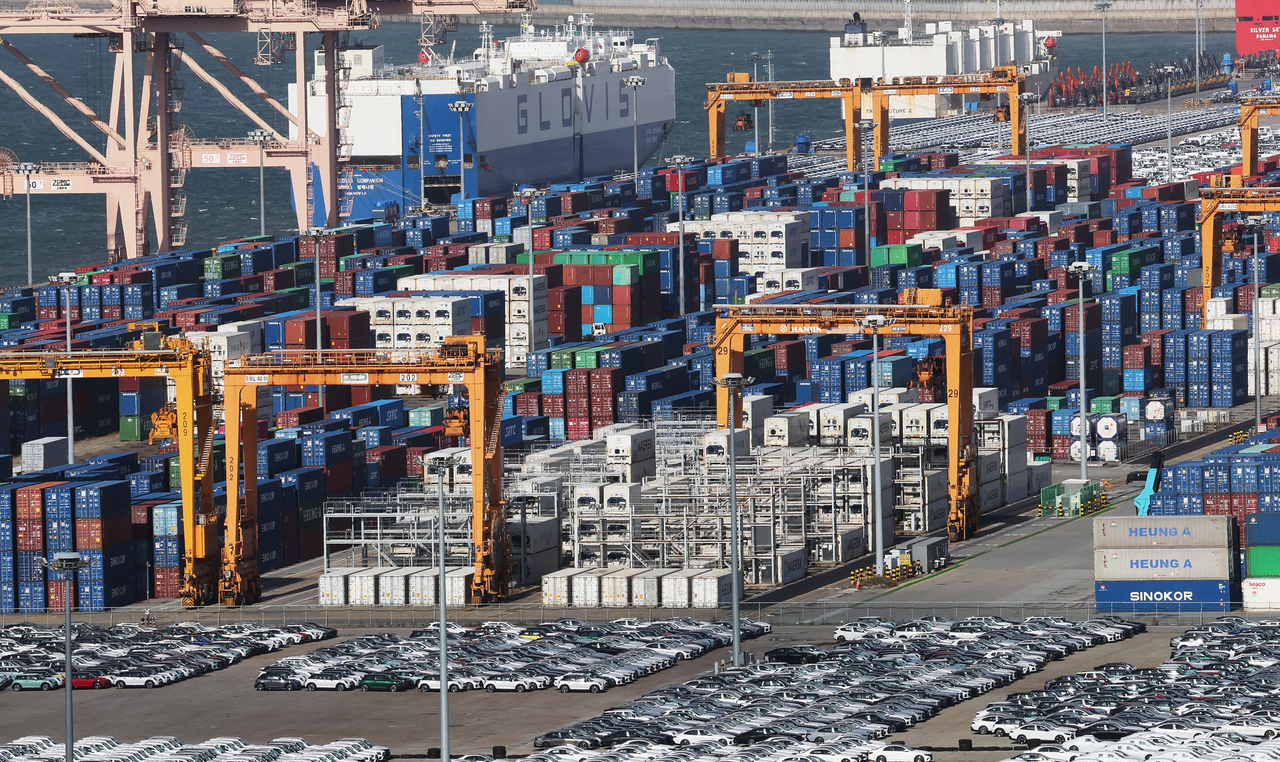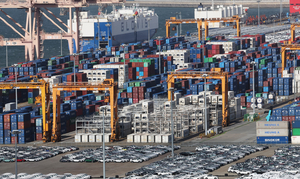State-run think tank revises growth outlook up to 0.9% for 2025, 1.8% in 2026, pointing to consumption-led recovery
 Containers are stacked at Pyeongtaek Port in Gyeonggi Province on Nov. 2. (Yonhap)
Containers are stacked at Pyeongtaek Port in Gyeonggi Province on Nov. 2. (Yonhap)
Korea’s state-run Korea Development Institute raised its growth outlook for both 2025 and 2026, marking its first upward revision in a year, as private consumption shows signs of recovery.
In its second biannual economic outlook report, the institute forecast Korea’s gross domestic product to expand 0.9 percent this year, reflecting 0.3 percent growth on-year in the first half and 1.5 percent in the second, and marking a 0.1 percentage point increase from its August forecast.
Growth is expected to rise to 1.8 percent on-year in 2026, up from the previous estimate of 1.6 percent, with the economy likely to post a modest recovery driven by domestic demand despite softer exports, the KDI said.
Jung Kyu-chul, KDI’s director of economic outlook, said the latest revision was driven mainly by a stronger-than-expected rebound in semiconductor exports.
“The chip cycle was much better than we anticipated, and we expect the sector to continue performing above earlier expectations,” he said, adding that the new administration’s expansionary fiscal policy also contributed to the improved outlook.
The KDI’s 0.9 percent forecast aligns with the latest projections from the International Monetary Fund and the Bank of Korea, but falls slightly short of the 1 percent outlook from several institutions, including the Organization for Economic Cooperation and Development, amid improving conditions in Korea. Estimates suggest that fourth-quarter growth above minus 0.1 percent would push the annual rate to 1 percent.
Jung said the KDI’s relatively cautious view reflects expectations for a slight contraction in the final quarter.
“The strong growth in the third quarter was largely driven by concentrated fiscal support, such as government spending coupons,” he said. “Some of that effect is expected to fade in the fourth quarter, and a mild dip should be seen as a temporary adjustment within a broader recovery trend.”
The revision marks the first upward adjustment this year after a series of cuts. The KDI had initially forecast 2 percent growth for 2025 late last year, but lowered it to 1.6 percent in March amid political unrest following December’s martial law incident, and again to 0.8 percent in May, as global trade conditions deteriorated.
The KDI said the economy is gradually regaining momentum, supported by stronger consumption and steady export growth. GDP rose 1.2 percent in the third quarter from the previous quarter, the fastest pace this year, driven by gains in private consumption, up 1.3 percent, capital investment, up 2.4 percent, and exports, up 1.5 percent.
The recovery is expected to gather pace next year, said Jung. “Economic conditions remained sluggish through the first half but have gradually improved in recent months,” he said. “While the economy is still operating below potential, the downturn has moderated, and we expect the recovery to become more visible next year.”
Consumption is expected to remain the main growth driver through 2026 as Korea weathers slowing exports. The KDI projected outbound shipments to grow 1.3 percent next year, down from this year’s 4.1 percent expansion.
“The impact of tariff hikes is expected to gradually spread, which could lead to a mild slowdown in Korea’s export growth,” said Kim Ji-yeon, KDI’s lead economist for economic outlook.
She noted that the effects are already evident in major economies, including the United States, where inflation is rising and employment is weakening. China is also experiencing a broader slowdown, weighed down by a prolonged property market slump, she added.
For Korea, the slowing global economy — forecast by the IMF to expand 3.1 percent next year, slightly below this year’s 3.2 percent — will pose a headwind, while a strong semiconductor cycle and improving domestic demand are expected to support growth.
Despite weaker exports, the KDI stated improved trade terms are expected to bolster the current account, with a surplus of about $103 billion projected for next year, roughly in line with this year’s level.
The think tank warned that the elevated exchange rate remains a key risk factor. The Korean won has hovered mostly at over 1,400 to the US dollar since October amid escalating trade tensions, adding pressure to the broader economy.
Further depreciation could push inflation higher from its relatively stable 2 percent level, Kim said.
On Wednesday, the won briefly approached 1,470 per dollar before trading around 1,465 in the afternoon. For now, the KDI expects the currency to stay near its current range.
With the economy emerging from its trough, fiscal spending should be scaled back to ease concerns over fiscal deterioration, the economists said.
“The managed fiscal deficit ratio is projected to exceed 4 percent of GDP over the next few years, with the debt ratio also expected to rise rapidly,” Kim said. “To prevent large deficits from becoming entrenched, fiscal policy should gradually normalize its expansionary stance in line with the pace of growth.”
jwc@heraldcorp.com

